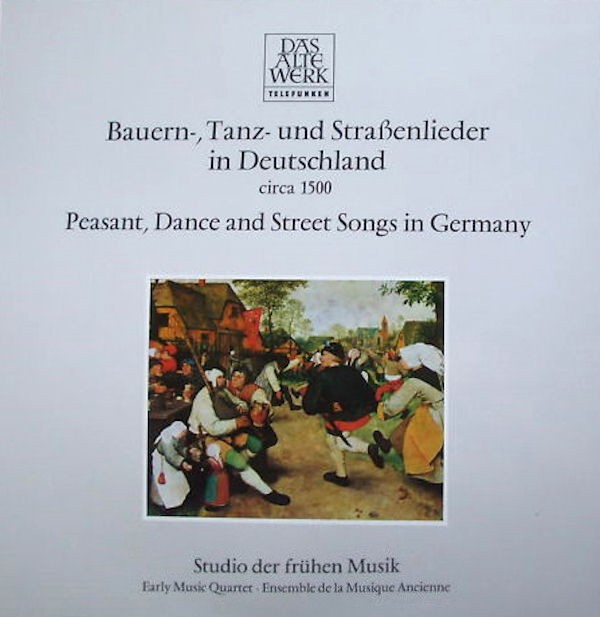
medieval.org
Telefunken "Das Alte Werk" SAWT 9486-A
1966
CD, 1998: Teldec "Das Alte Werk" 3984-21 804-2

medieval.org
Telefunken "Das Alte Werk" SAWT 9486-A
1966
CD, 1998: Teldec "Das Alte Werk" 3984-21 804-2
(A)
Stefan MAHU (c.1490—1540)
1. Es gieng ein wolgezogner knecht [1:23]
mezzo-soprano, tenor C, 2 viols, lute
2. Es wolt ein meydlin wasser holn [2:14]
mezzo-soprano, portative, rauschpfeife, crumhorn, viol
3. Ein meidlein tet mir klagen [1:52]
baritone, 3 viols
4. Ein pauer gab sein son ein weib [2:31]
mezzo-soprano, tenor R, baritone, kortholt, crumhorn, viol
Ludwig SENFL (c.1480—1542)
5. Es hett ein biderman ein weib [2:10]
mezzo-soprano, tenors C R, baritone, 4 crumhorns
6. Es wolt ein fraw zum Weine gan [0:52]
baritone, 3 crumhorns
7. Ich het mir ein endlein fürgenommen [0:47]
mezzo-soprano, tenor C, viol, lute
8. Die prünle, die da fließen [1:08]
tenor C, 3 viols
Ludwig SENFL
9. Ich stund an einem morgen [3:03]
tenor R, portative, viol, lute
10. Es taget vor dem Wald [1:39]
tenor C, baritone, 3 viols
11. Es warb ein schöner jüngling [1:41]
mezzo-soprano, 3 viols
Ludwig SENFL
12. Quodlibet. Es taget vor dem Wald - Es warb [1:04]
mezzo-soprano, tenor C, 2 viols
13. Es ist ein schnee gefallen [1:38]
mezzo-soprano, lute (arr. Thomas Binkley)
Thomas STOLTZER (c.1480—1526)
14. Entlawbet ist der walde [4:15]
tenor C, 3 viols
(B)
Ludwig SENFL
15. Ich weiß nit was ehr ihr verhieß [1:01]
mezzo-soprano, tenor R, baritone, cornetto, viol
16. Im maien [1:54]
tenor R, flute, portative, viol
17. Den meinen Sack [1:36]
mezzo-soprano, crumhorn, viol
18. Der Vechlienlin [2:04]
baritone, 2 crumhorns, viol
19. Ich trau keinm alten - Ach guter gsell [5:44]
mezzo-soprano, tenor C, rauschpfeife, 2 crumhorns, viol
Ludwig SENFL
20. Im bad wöl wir recht frölich sein [2:27]
baritone, crumhorn, viol, lute
21. Ich weet en Vrauken amorues [1:57]
tenor C, rauschpfeife, crumhorn, viol
Ludwig SENFL
22. Ich armes megdlein klag mich ser [3:40]
mezzo-soprano, 3 viols
23. Nun zu disen zeyten [1:33]
mezzo-soprano, tenor R, crumhorn, viol
24. Den besten vogel den ich weiß [1:33]
mezzo-soprano, tenor R, viol, viol
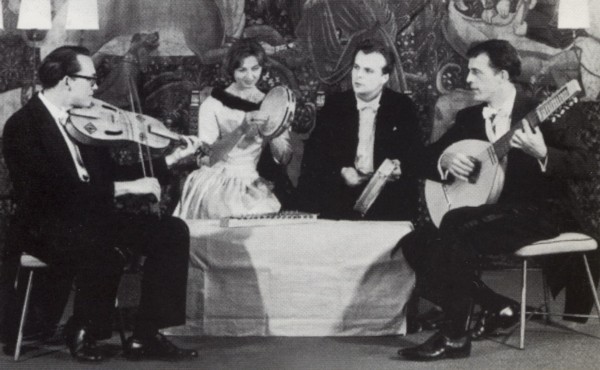
STUDIO DER FRÜHEN MUSIK
Early Music Quartet
Thomas Binkley
Andrea von Ramm, mezzo-soprano, portative
Thomas Binkley, lute, crumhorn, rauschpfeife, kortholt, flute
Willard Cobb, tenor, crumhorn
Sterling Jones, viol, crumhorn
&
Nigel Rogers, tenor (#4, 5, 9, 15, 16, 23, 24)
Karl Heinz Klein, baritone
Johannes Flink, viol
Udo Klotz, viol
Don Smithers, cornetto
Recorded AEG Studio, Munich, Germany,
08/1963 (tracks #4, 5, 9, 15, 16, 23, 24) & 04/1966
Ⓟ 1964 TELDEC
CD, digitally remastered © 1998 TELDEC
Cover: Peasant Dance, painting by Pieter Brueghel the elder (c1525-1569)
(Archiv für Kunst und Geschichte, Berlin)
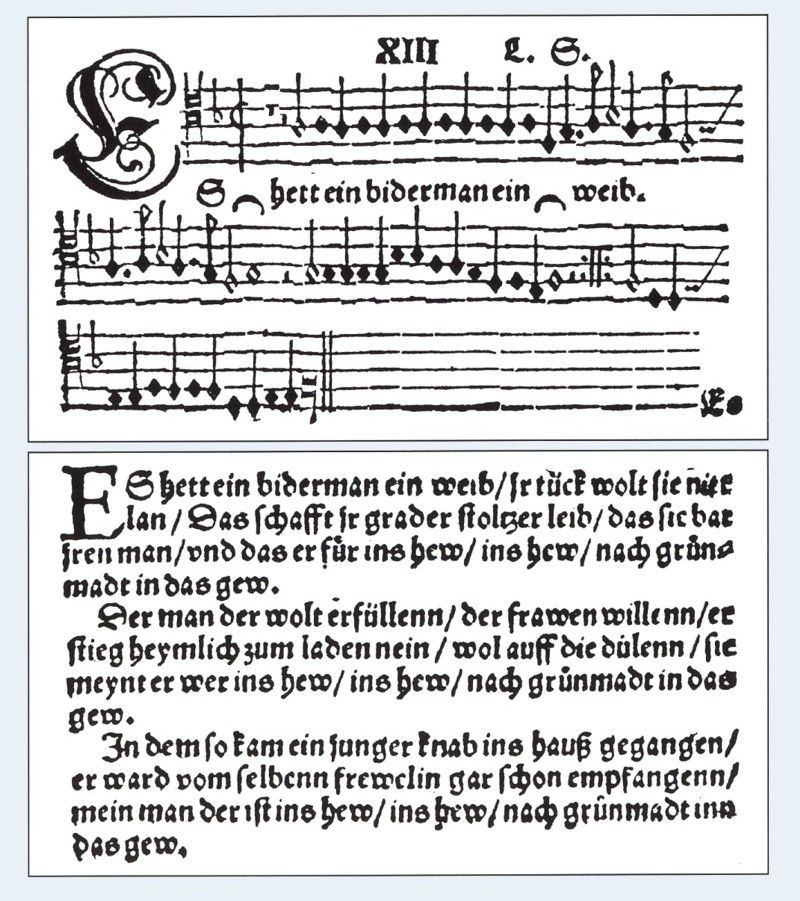
This
is a collection of witty, bucolic, and popular German songs from the
early 16th century, the age of the emperor Maximilian and of Dürer,
Erasmus, and Luther. They were genuinely popular, and quite different to
the serious repertory of the humanists or the love songs of the courts.
In fact, the ballads and songs of the townsfolk were full of burlesque
fun, satire, and earthy humour. It is true that humanists such as Konrad
Celtes and Joachim Vadian criticized certain composers and indeed the
frivolity of the whole genre. However, the very same composers continued
to be held in high esteem on account of their serious religious music.
And arranging popular songs was clearly something which they found
rather amusing, for there are numerous examples of a composer making
more than one arrangement of the same song.
In fact, making
arrangements of what was often simply referred to as "borrowed material"
was a standard feature of the contemporary composer's art. (Similarly,
research into such arrangements has now become a common musicological
pastime.) Regional styles of arrangement were in some ways related to
the predominant national style of composition. For example, around 1500
German arrangements were nearly always in four parts, with the melody in
the tenor voice. They were designed for a singer accompanied by two
treble instruments and a bass. However, the complexity of the various
arrangements differed significantly. Although simple settings in the
style of a chorale were not uncommon, many composers preferred to weave
interesting contrapuntal lines into the accompaniment, and to make
extensive use of imitation and canon. In the course of time popular
songs began to be turned into unaccompanied madrigals. Sometimes, as in
the case of the quodlibet, a number of songs were included in a single
madrigal. This heralded the decline of the genre, the success of which
had depended on its solo narratives, its charming naivety, and its
personal character. Without these features, the songs lack immediacy and
a specifically bucolic character.
In the 16th century regional
traditions and preferences were the source of major stylistic
differences. Thus it is no accident that the styles personified by Dürer
and Michelangelo, who were contemporaries, were so strikingly
different. In music, stylistic traditions existed not only in the field
of composition, but also in that of performance. There were clearly
distinct regional styles, which included the preference for certain
instruments and the style of singing. In Italy, for example, string
instruments were considered to be more "noble" than "vulgar" winds: the
Apollonian principle had triumphed over the Dionysian one. For this
reason string instruments tended to be used in the aristocratic circles
which patronized both composers and performers. However, German
aristocrats were obviously not as Apollonian as their Italian
counterparts. Nor were their tastes as sophisticated. In Germany
instruments were not employed symbolically, and there was no Castiglione
to proclaim the nobility and superiority of string instruments.
In
Italy and France the culture of the courts was considered to be refined
and sophisticated, and that of the street crude and unpolished.
However, in Germany a distinction tended to be drawn between the culture
of the city (which was deemed to be high) and that of the country
(which was considered to be low). Similar traditions and predilections
governed the treatment of instruments. Thus the evidence at our disposal
can help us to solve the problem of instrumentation. The notion that
Renaissance music was not written for specific instruments is
questionable, for we know which instruments tended to be grouped
together. For example, the trombone and cornett were often used with
voices, the lute with viols, the crumhorn with shawms and a trombone,
and so on. It is usually possible to discover the best and what was
probably the original instrumentation by adhering to such guidelines,
and by bearing in mind the character of the instruments and their
specific musical qualities.
The music on this CD was popular in
origin and popular in character. And it was designed for popular
consumption. As such it affords a unique insight into an aspect of life
in Renaissance Germany. Its most striking quality is humour, and it
depicts common attitudes towards institutions and human frailty which
were no doubt shared by contemporary listeners.
Thomas Binkley (1966, rev. 1998)
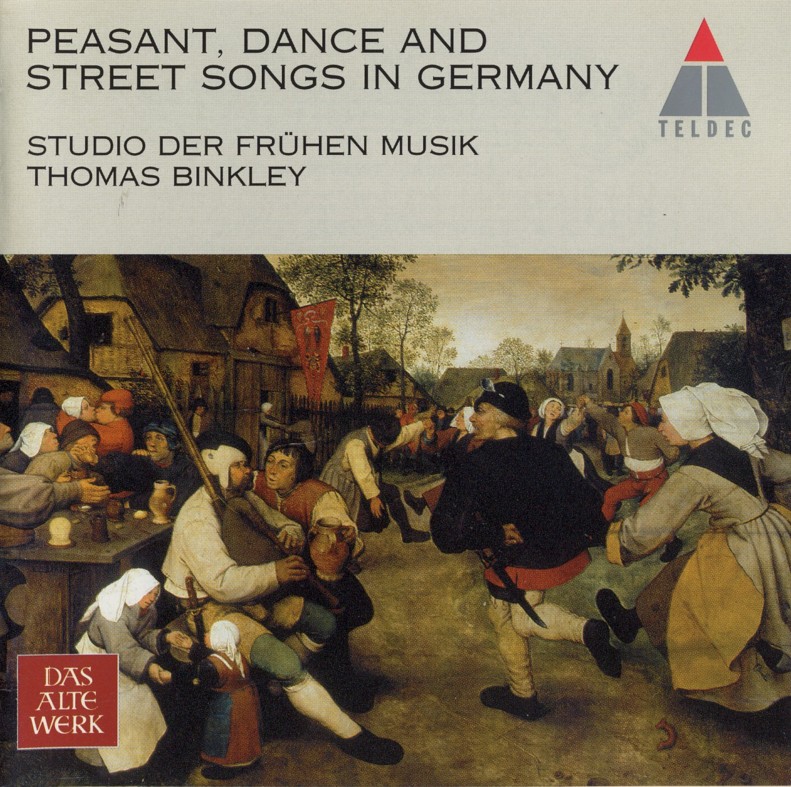
Teldec "Das Alte Werk" 3984-21 804-2
Vierzig Jahre jung: DAS ALTE WERK
Selten
gelingt es, ein Programm über einen solchen Zeitraum immer wieder mit
neuem Leben, mit neuen Impulsen zu füllen. Dem ALTEN WERK ist es
gelungen. Die Idee: hochprofessionelle Interpretationen auf
Originalinstrumenten. 1958 erschienen die ersten Schallplatten des ALTEN
WERKS, noch in Mono und aus schwarzem PVC gepreßt. Man hatte eine gute
Hand bei der Auswahl der Interpreten: Sie sollten stilbildend werden,
und ihre Aufnahmen können heute historischen Rang beanspruchen. Vor
allem in Holland wirkende Musiker um Gustav Leonhardt kamen Anfang der
60er Jahre zum ALTEN WERK: So Frans Brüggen, der mit stupender
Virtuosität die Blockflöte von den Zwängen des Banalen der
Gemeinschaftsmusik befreite. so der Cellist Anner Bylsma und der Geiger
Jaap Schröder. Geistesverwandt, wenn auch aus einer ganz anderen Region
stammend: Nikolaus Harnoncourt mit seinem Concentus musicus Wien. Der
junge Harnoncourt sollte dann auch die wichtigsten künstlerischen
Impulse bringen — und er ist seit seinen ersten Aufnahmen für Teldec
1963 dem Label treu geblieben: Von Monteverdi bis zu Mozart reichen
seine unzähligen Aufnahmen für das ALTE WERK, die ganze Vielfalt der
barocken Musik umfassend. Einen Schwerpunkt bildeten sämtliche
geistliche Kantaten Bachs; ein Projekt, das sich Hamoncourt und
Leonhardt teilten und das im Bach Jubiläumsjahr 1985 abgeschlossen
werden konnte. Von Anfang an hat DAS ALTE WERK Musik auch jener Epochen
vorgestellt, die erst in jüngeren Jahren auf breiteres Interesse
gestoßen sind: Die Vokalmusik der Renaissance sang die Capella Antiqua
München unter der Leitung von Konrad Ruhland. Und Thomas Binkley und
sein Studio der Frühen Musik erfüllten mittelalterliche Quellen mit
musikantischen Leben. Auch wenn das gesamte Spektrum von Gregorianischen
Hymnen und mittelalterlichen Tänzen bis zu Schuberts Sonaten auf dem
Fortepiano und den Streichersinfonien des jungen Mendelssohn-Bartholdy
im ALTEN WERK erschienen ist: immer stand und steht die Qualität der
Musik und ihrer Interpreten im Vordergrund. Das macht die Aufnahmen des
ALTEN WERKS, worunter sich viele Ersteinspielungen befinden, so
interessant. In neuester Zeit hat DAS ALTE WERK mit dem Cembalisten und
Pianisten Andreas Staier, mit dem Concerto Köln und mit dem
italienischen Ensemble II Giardino Armonico Künstler vorgestellt, die
der alten Idee faszinierend neue Seiten abgewonnen haben. Und es sieht
so aus, als ob Das ALTE WERK weiterhin so jung bleibt wie in seinen
ersten vierzig Jahren.
In den 60er Jahren entsprachen die vier Musiker des Studios der Frühen Musik rein äußerlich dem normalen Erscheinungsbild des Musikers; die Herren in Fliege und Frack, die Sängerin Andrea von Ramm
im Abendkleid. Doch das war alles, was dieses Ensemble mit der
herkömmlichen Musik gemein hatte. Man spielte auf so exotischen
Instrumenten wie dem Rebec und dem Pommer, und die 1928 geborene Andrea
von Ramm sang mit ganz eigentümlicher, fast androgyner Tongebung. Hier
erklang eine Musik, die beides war: alt und gleichzeitig unglaublich
aktuell. Nicht von ungefähr hatte sich die Sängerin vorher mit neuer
Musik beschäftigt. Damit bildete das Studio der Frühen Musik, das der
1931 geborene amerikanische Lautenist Thomas Binkley 1960 in
München gründete, einen Stil, der später von Musikern wie David Munrow
aufgegriffen wurde und dank der vielen Schallplatten des Ensembles in
alle Welt hinausgetragen wurde.
Die Stammbesetzung bestand neben dem 1995 gestorbenen Binkley und Andrea von Ramm aus dem Amerikaner Sterling Jones (alte Streichinstrumente) und dein Engländer Nigel Rogers (Tenor, Schlaginstrumente), der schon bald von einem anderen Engländer, von Willard Cobb, und später dann von Richard Levitt abgelöst wurde.
Die
Teldec hatte frühzeitig die Meriten des Ensembles entdeckt und
produzierte viele mit den vier Musikern und einer Reihe von
«Gastkünstlern« Repertoirelücken des Mittelalters und der Renaissance,
Aufnahmen, die durchgängig die Kritik begeisterten. Bis 1977 bestand das
Studio der Frühen Musik; in den knapp zwei Jahrzehnten seines Wirkens
entstanden etwa 50 Schallplatten — Aufnahmen, die Geschichte gemacht
haben.
Martin Elste
Forty Years young: DAS ALTE WERK
From a purely physical standpoint, the four members of the Studio der Frühen Musik looked just like any other musicians of the 1960s: the men disported themselves in tie and tails, while the soprano Andrea von Ramm
wore evening dress. But that was all that these musicians had in common
with traditional forms of music-making. They played on exotic
instruments such as the rebec and shawm, while Andrea von Ramm's singing
had a strange, almost androgynous quality to it. The result was a kind
of music that was both old and incredibly new. It was no accident that
Andrea von Ramm, who was born in Estonia in 1928, had earlier been
associated with contemporary music. In this way, the Studio der Frühen
Musik helped to forge a style of performing early music that was later
taken up by other musicians such as David Munrow and carried all round
the world in the form of the ensemble's innumerable gramophone
recordings.
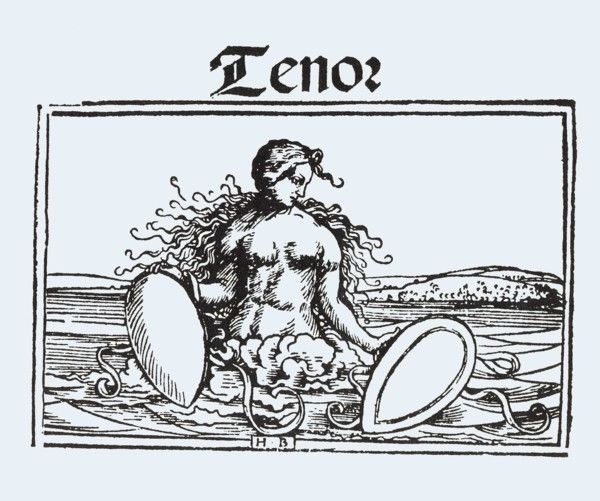
Only rarely is it possible to breathe new life into one and the selfsame product over such a lengthy period of time and
keep on investing it with new ideas. But DAS ALTE WERK has done just that
with its underlying idea of presenting supremely professional
performances on period instruments. The first recordings on the DAs ALTE
WERK label appeared in 1958 — still in mono and in the form of black
vinyl discs. But fate had dealt the label an excellent hand in its
choice of performing artists, all of whom were to prove influential in
creating a specific style, so that their recordings can now lay claim to
historic status. Above all, it was artists living in the Netherlands
and associated with the figure of Gustav Leonhardt who came to DAS ALTE
WERK in the early 1960s. Here one thinks not only of Frans Brüggen,
whose stupendous virtuosity freed the recorder from its banal reputation
as an instrument for schoolchildren, but also of the cellist Anner
Bylsma and the violinist Jaap Schröder. Spiritually akin to these
musicians, but from a different part of Europe, is Nikolaus Harnoncourt
and his Vienna Concentus musicus. Indeed, it was the young Harnoncourt
who was to provide the label with its most important artistic stimuli
and who has remained loyal to Teldec since his very first recordings for
the company in 1963. His countless later recordings for DAS ALTE WERK
range from Monteverdi to Mozart and cover the whole vast span of Baroque
music in all its manifold guises. One particular focus of interest was
his complete recording of all Bach's sacred cantatas in the form of a
project divided between himself and Gustav Leonhardt and completed in
1985 to mark the tercentenary of the Thomaskantor's birth. From the very
outset, DAs ALTE WERK has featured music from periods that only later
have met with more widespread interest: Renaissance vocal music, for
example, was recorded by the Munich Capella Antigua under the direction
of Konrad Ruhland, while Thomas Binkley and his Studio der Frühen Musik
breathed new and vibrant life into their medieval goliardic sources.
Although the range of music that has appeared on the Dm ALTE WERK label
extends from Gregorian chant and medieval dances to Schubert sonatas
played on a fortepiano and the young Felix Mendelssohn's string
symphonies, it is the quality of the music and its performers that has
always been to the fore. It is this — and the fact that Das ALTE WERK
has featured many works never previously recorded — that makes these
recordings so interesting.
Among recent artists and ensembles to
appear on the DAS ALTE WEAK label are the harpsichordist and
fortepianist Andreas Staier, the German ensemble Concerto Köln, and the
Italian group Il Giardino Annonico, all of whom have shed fascinating
new light on the old idea. It looks very much as though DAS ALTE WERK
will continue to renew itself and remain as eternally youthful in the
future as it has done during its first forty years of existence.
The Studio der Frühen Musik was founded in 1960 by the American lutenist Thomas Binkley (1931-1995) and centred on three performers: Binkley himself, the American string player Sterling Jones and the English tenor Nigel Rogers, who also doubled as percussionist and who was later succeeded by another English musician, Willard Cobb, and, finally, by Richard Levitt.
Teldec
discovered the ensemble's qualities at a very early date and made many
recordings with the four members of the Studio der Frühen Musik, who
were joined on these occasions by a whole series of guest artists and
who in this way filled many gaps in the recorded repertory of medieval
and Renaissance music, recordings that were invariably enthusiastically
received by critics. By the time that the Studio der Frühen Musik was
disbanded in 1977 it had made some fifty recordings, all of which made
gramophone history.